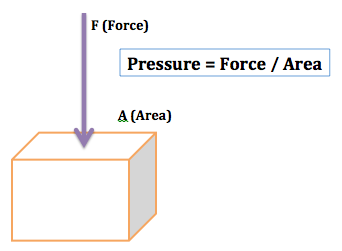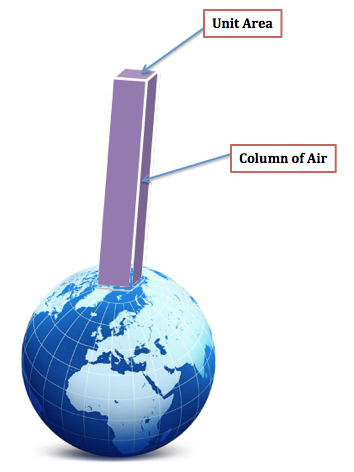Atmosphere » Pressure
1.6 Pressure (Symbol: P or p)
Definition
Pressure is defined as the force per unit area.

Pressure = (Force / Area)
= (Mass x Acceleration)/Area
In the atmosphere, pressure is caused by the mass of the gaseous molecules acting under the force of gravity on a given area. As all molecules act under gravity then the pressure can also be considered to be the weight of a column of air on a unit area.

Units
The metric unit for pressure is dynes per square centimetre, where the dyne is the force required to accelerate 1 gram by 1 centimetre per second.
The System International unit for pressure is Newtons per square metre, where the Newton is the force required to accelerate 1 kilogram by 1 metre per second.
The Newton is therefore, equal to 105 dynes.
Although largely obsolete, the Imperial system of units is still encountered, and pressure is expressed in pounds per square inch.
In meteorology the unit of pressure is the millibar (mb), which is equivalent to 1000 dynes per square centimetre. Before the introduction of the millibar, meteorological pressure was measured in terms of the length of a column of mercury in a barometer that the weight of the atmosphere could support.

Variation of Pressure in the Atmosphere
At sea level, pressure generally varies between 950 and 1050 mb. In tropical revolving storms and tornadoes, however, pressures may fall much lower. With increasing altitude the mass of overlying air decreases and so the pressure falls. Pressure values of the International Standard Atmosphere are given below:
|
Altitude (ft) |
Pressure (mb) |
Pressure (PSI) |
Pressure (inHg) |
Pressure (mmHg) |
|
40000 |
188 |
2.72 |
5.54 |
141 |
|
30000 |
301 |
4.36 |
8.89 |
225.8 |
|
20000 |
466 |
6.75 |
13.74 |
349.5 |
|
10000 |
697 |
1 0.10 |
20.57 |
522.8 |
|
0 (Sea Level) |
1013 |
14.7 |
29.92 |
759.8 |
From the table it should be noted that at about 18,000 ft, the pressure is half the sea level value. Also, it should now be apparent that the rate of pressure decrease with height is not constant. In the first 10,000 ft, the pressure falls at a rate of approximately 1 mb per 30 ft but between 30,000 ft and 40,000 ft the pressure decrease is closer to 1 mb per 88 ft.
Pressure Altitude
The altitude at which a given pressure occurs in the International Standard Atmosphere is called the pressure altitude. If, for example, the pressure at the top of Mount Everest were determined as 300.9 mb, then the pressure altitude would be 30,000 ft. Assuming the same mean sea level conditions, and two columns of air of the same height, but differing temperatures, then the cold air would have a greater mass than the warm air due to the density difference. The pressure of the atmosphere, however, is caused by the mass of overlying molecules on a unit area. The pressure above the column of warm air is therefore higher than that above cold air. Because a higher pressure is found at a lower level, then the pressure altitude above warm air is lower than the pressure altitude above cold air. Alternatively it can be expressed that the true altitude of an aircraft is more than that indicated (assuming the correct mean sea level pressure has been set on the sub-scale) above warm air, and less than that indicated above cold air. (Fig 1-4)

